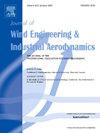几何细节和外部因素对单箱甲板气动弹性性能的影响
IF 4.9
2区 工程技术
Q1 ENGINEERING, CIVIL
Journal of Wind Engineering and Industrial Aerodynamics
Pub Date : 2025-09-25
DOI:10.1016/j.jweia.2025.106237
引用次数: 0
摘要
Julsundet大桥是挪威E39峡湾穿越工程的一部分,主跨1625米,将成为欧洲最长的悬索桥。它的单箱甲板设计,选择气动效率,接近挪威标准规定的临界颤振速度限制。本研究通过风洞实验和数值分析研究了桥梁的气动弹性稳定性,重点研究了几何细节(如障碍物和龙门架)和外部因素(如积雪)的影响。在米兰理工大学进行的风洞测试评估了各种配置,以在不改变甲板主要几何形状的情况下优化稳定性。积雪是北欧气候的一个重要因素,也被模拟以评估其影响。数值多模态分析补充了这些实验,提供了对颤振机制的见解。结果表明,单箱式甲板具有良好的气动稳定性,其中圆形龙门轨道的气动性能最好。然而,积雪大大降低了稳定性,强调了维护协议和监测系统的必要性。除了在下雪的情况下,在典型条件下没有观察到涡激振动。本研究证明了Julsundet大桥单箱桥面方案的可行性,并为大桥的设计、维护和运营提供了实用的见解。本文章由计算机程序翻译,如有差异,请以英文原文为准。
Influence of geometric details and external factors on the aeroelastic behavior of a single-box deck
The Julsundet Bridge, part of Norway’s E39 fjord-crossing project, is set to become Europe’s longest suspension bridge with a 1625-meter main span. Its single-box deck design, chosen for aerodynamic efficiency, approaches the critical flutter speed limit defined by Norwegian standards. This study investigates the bridge’s aeroelastic stability through wind tunnel experiments and numerical analysis, focusing on the effects of geometry details, such as barriers and gantry rails, and external factors like snow accumulation.
Wind tunnel tests conducted at the Politecnico di Milano evaluated various configurations to optimize stability without altering the deck’s primary geometry. Snow accumulation, a significant factor in Nordic climates, was also simulated to assess its impact. Numerical multi-modal analysis complemented these experiments, providing insights into flutter mechanisms.
Results indicate that the single-box deck is aerodynamically robust, with the circular gantry rails offering the best performance. However, snow accumulation substantially reduces stability, highlighting the need for maintenance protocols and monitoring systems. Vortex-induced vibrations were not observed under typical conditions, except during snow scenarios.
This research demonstrates the feasibility of the single-box deck solution for the Julsundet Bridge and it provides practical insights for the design, maintenance, and operation of the bridge.
求助全文
通过发布文献求助,成功后即可免费获取论文全文。
去求助
来源期刊
CiteScore
8.90
自引率
22.90%
发文量
306
审稿时长
4.4 months
期刊介绍:
The objective of the journal is to provide a means for the publication and interchange of information, on an international basis, on all those aspects of wind engineering that are included in the activities of the International Association for Wind Engineering http://www.iawe.org/. These are: social and economic impact of wind effects; wind characteristics and structure, local wind environments, wind loads and structural response, diffusion, pollutant dispersion and matter transport, wind effects on building heat loss and ventilation, wind effects on transport systems, aerodynamic aspects of wind energy generation, and codification of wind effects.
Papers on these subjects describing full-scale measurements, wind-tunnel simulation studies, computational or theoretical methods are published, as well as papers dealing with the development of techniques and apparatus for wind engineering experiments.

 求助内容:
求助内容: 应助结果提醒方式:
应助结果提醒方式:


